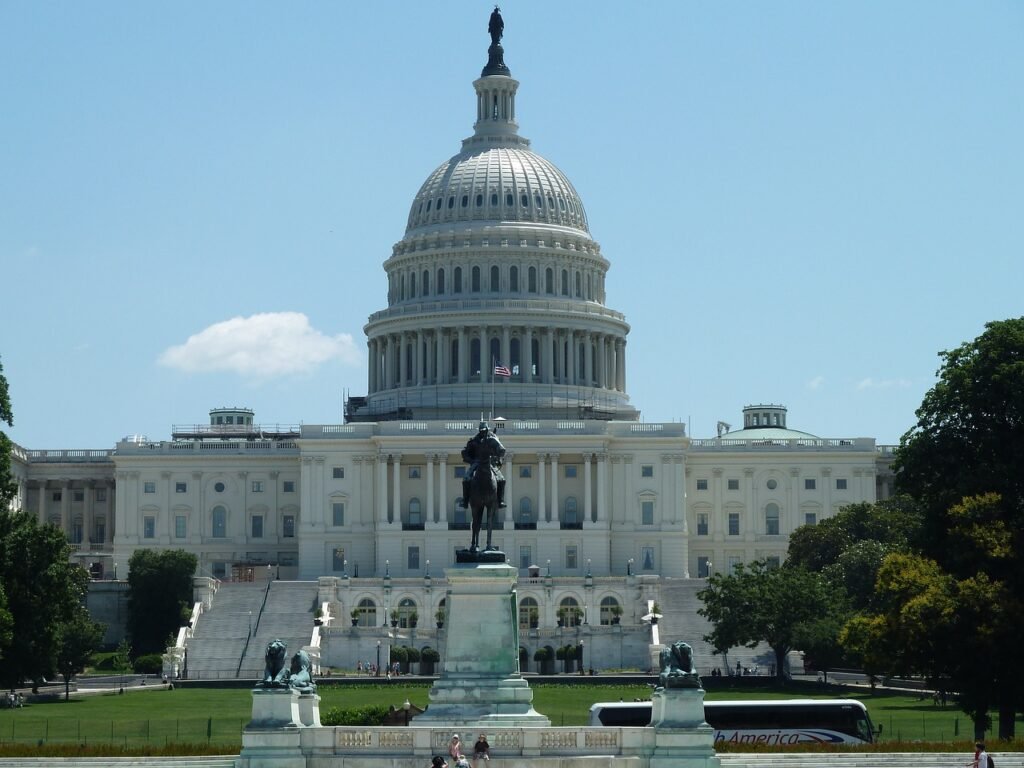If you’re planning a trip to D.C., get ready! Our nation’s capital is a place where history, culture, and politics blend seamlessly. You’ll find stunning monuments, world-class museums, and iconic government buildings.
But do you know what not to do in Washington D.C.?
If you don’t, you could fall into some common tourist traps that might put a damper on your experience. Luckily, I’ve been to D.C. a few times, and I’m here to help you avoid those first-time mistakes.
Whether you’re planning to visit the National Mall, check out the Smithsonian museums, or just wander around the vibrant neighborhoods, I’ve got tips that will help you enjoy your trip to the fullest. So, let’s jump into what not to do in Washington D.C.!
1. Don’t Try to See Everything in One Day

The first thing you need to know about D.C. is that there’s a lot to see and do. From the Capitol Building to the Washington Monument, the Lincoln Memorial, and countless museums, there’s no way you can see it all in one day—or even a few days.
Pace Yourself
I remember my first trip to D.C., and I was overly ambitious. I thought I could hit up several Smithsonian museums, walk around the National Mall, and still make it to Arlington Cemetery by sunset.
Spoiler alert: it didn’t happen. I ended up completely exhausted by midday.
Take it from me: D.C. is best enjoyed at a slower pace. Pick a few key places you really want to see, and take your time. This way, you’ll have a more enjoyable experience and won’t feel rushed or overwhelmed.
Break It Down by Area
A good strategy is to break your itinerary into different neighborhoods or areas.
For example, you can spend one day exploring the National Mall and the museums around it, another day in Georgetown, and maybe a third day in Capitol Hill or Dupont Circle. This way, you’re not darting across the city and exhausting yourself before lunch.
2. Don’t Skip the Free Attractions

One of the best things about D.C. is that many of its attractions are free! Yep, you read that right. Some of the most famous museums and landmarks don’t charge admission.
But here’s where a lot of first-time visitors go wrong—they either don’t realize this or they assume the free spots aren’t as good as the paid ones.
Check Out the Smithsonian Museums
The Smithsonian Institution consists of multiple museums and galleries, and they’re all free!
You can visit:
- the National Museum of American History
- the Air and Space Museum
- the National Museum of African American History and Culture
…and many more. Trust me, these museums are world-class, and you’ll be kicking yourself if you miss out on them.
Monuments and Memorials Are Free Too!
Walking around the National Mall and seeing:
is an experience you can’t put a price on—and you don’t have to! These iconic landmarks are free to visit, and the memories you’ll make here will last a lifetime.
3. Don’t Ignore the Importance of Timing
Timing is everything in D.C. Whether it’s when you visit certain attractions or how you plan your meals, being aware of timing will save you a lot of headaches.
Go Early to Avoid Crowds
Popular spots like:
can get incredibly crowded, especially during peak tourist seasons (spring and summer) and school holidays.
Plan to visit major attractions early in the morning when it’s quieter and cooler. Not only will you beat the crowds, but you’ll also get better lighting for photos!
Plan Around the Cherry Blossom Season
If you’re visiting D.C. in the spring, you might be tempted to see the famous cherry blossoms. It’s a stunning sight, but cherry blossom season also attracts huge crowds.
If you’re coming specifically for the blossoms, try to go during the week rather than on the weekend to avoid the biggest rush.
And if you can, catch them early in the morning when the Tidal Basin area is less crowded.
The next thing not to do in Washington D.C. is a big one…
4. Don’t Underestimate the Walking Distances
Washington D.C. is very walkable, but the distances between attractions might be longer than you think.
On a map, the National Mall might look like a short stroll, but walking from the Capitol to the Lincoln Memorial can take you over 30 minutes, and that’s not counting the time you’ll spend stopping to admire everything along the way.
Wear Comfortable Shoes
Wear comfortable walking shoes that will support you through a day of sightseeing. You’ll be doing more walking than you expect, and blisters are no fun when you’ve still got half the city to explore.
Use Public Transportation or Rideshares When Needed
If your feet start to get tired, don’t be afraid to use public transportation. The D.C. Metro is a convenient way to get around, and it’ll save you a lot of energy.
There are also plenty of buses, and rideshare services like Uber and Lyft are widely available if you need a quick ride to your next destination.
5. Don’t Drive in Downtown D.C. if You Can Avoid It
Driving in Washington D.C., especially around the downtown area, can be a real headache. Traffic is often heavy, and parking can be hard to find (and expensive).
Plus, many streets are confusing with roundabouts, one-way roads, and unexpected closures.
Use Public Transportation Instead
The D.C. Metro system is a fantastic way to get around. It’s clean, affordable, and can take you to many of the major attractions without the hassle of driving.
If You Must Drive, Be Prepared for Parking Costs
If you’re set on driving, be aware that parking garages can be expensive, and street parking can be hard to find. Make sure to have a parking app or some change handy if you plan on using metered parking.
6. Don’t Assume You’ll Get Same-Day Tickets to Popular Sites

Some of D.C.’s most famous attractions require tickets, and unfortunately, you can’t always get them the day of your visit.
Places like the U.S. Capitol, White House, and the Holocaust Museum often require advance reservations, especially during peak tourist seasons.
Plan Ahead
On my first trip to D.C., I showed up at the Holocaust Museum hoping to get tickets at the door. Nope. They were sold out for the entire day, and I was really disappointed.
To avoid this, do some research before your trip and reserve tickets for the places you want to visit in advance. Most museums and tours allow you to book tickets online, and it’s usually free—you just need to plan ahead.
Check for Free Timed Entry Tickets
Many popular sites offer free tickets but require you to reserve a time slot.
For example, if you want to tour the Capitol Building or visit the Washington Monument, you’ll need to reserve your spot online beforehand.
7. Don’t Forget About Security and Bag Restrictions
Since D.C. is home to many important government buildings, security is tight at a lot of the major attractions. You’ll often have to go through metal detectors and have your bags checked, and some places have specific rules about what you can and can’t bring inside.
Pack Light
When visiting places like the Capitol, White House, or some museums, it’s best to pack light. Large bags and backpacks are often not allowed, and carrying them will just slow you down at security checkpoints.
Stick to a small bag or purse and check the security requirements for each place before you go. I always take my sling with me to make it super easy.
Be Prepared for Security Lines
Depending on the time of day and season, security lines can get long at certain attractions. If you’re visiting high-traffic areas like the Capitol or the Library of Congress, be sure to arrive early to allow time for security screening.
8. Don’t Skip the Neighborhoods Beyond the National Mall
While the National Mall is packed with amazing sites, D.C. has so much more to offer beyond its famous monuments and museums. Exploring the city’s neighborhoods will give you a more authentic experience and let you see D.C. through the eyes of a local.
Check Out Georgetown
Georgetown is one of the oldest neighborhoods in D.C., and it’s filled with charming historic streets, boutique shops, and fantastic restaurants.
Walking around Georgetown feels like stepping back in time, and it’s the perfect spot for a relaxing afternoon.
Don’t Miss Adams Morgan and Dupont Circle
If you’re looking for a vibrant nightlife scene or some eclectic dining options, check out Adams Morgan and Dupont Circle. These neighborhoods have a funky, bohemian vibe and are full of great food, local bars, and live music.
You’ll find everything from international cuisine to quirky bookshops, and it’s a nice break from the more touristy areas.
9. Don’t Forget to Take Time for a Relaxing Break
Washington D.C. is exciting, but it can also be overwhelming, especially with all the history, politics, and bustling crowds. It’s easy to pack your itinerary to the brim and forget to take a breather.
Relax by the Tidal Basin
One of my favorite places to unwind in D.C. is the Tidal Basin, especially during the spring when the cherry blossoms are in bloom.
It’s a beautiful, peaceful spot where you can sit, enjoy the view, and just take a break from all the sightseeing.
Take a Stroll Through Rock Creek Park
If you want to escape the hustle and bustle for a while, Rock Creek Park offers a great escape right in the middle of the city.
You can go for a walk, have a picnic, or just enjoy the greenery. It’s an unexpected oasis in a city known for its political power.
Final Thoughts
Washington D.C. is an amazing city with so much to offer. Whether you’re interested in history, culture, politics, or just seeing some incredible sights, there’s something for everyone here.
And now that you know what not to do in Washington D.C., you’ll have a smoother, more enjoyable trip—and you’ll leave D.C. with memories that will last a lifetime. So, pack your comfortable shoes, plan ahead, and get ready for an unforgettable adventure in the nation’s capital. Happy travels!
Explore more. Fear less.
- Why Road Trips are One of the Best Ways to Clear Your Mind - November 21, 2024
- 10 of the Best Pumpkin Patches in the U.S. - October 23, 2024
- 10 of the Most Colorful Fall Road Trips in the U.S. - October 22, 2024
